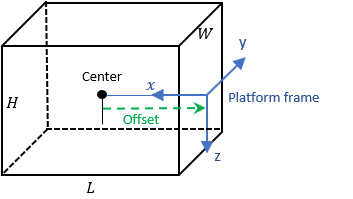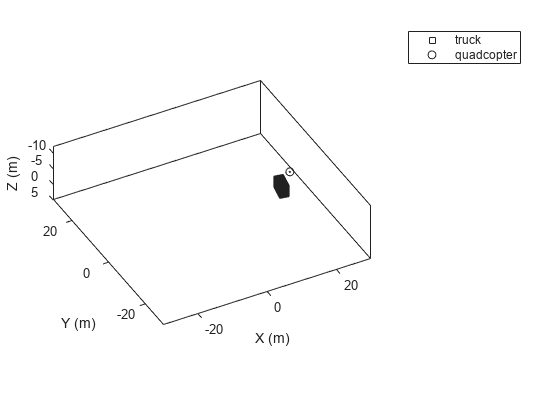Platform
Description
Platform defines a platform object belonging to a radar
scenario.
Creation
You can create Platform objects using the platform function
of the radarScenario
object.
Properties
This property is read-only.
Scenario-defined platform identifier, specified as a positive integer. The scenario
automatically assigns PlatformID values to each platform, starting
with 1 for the first platform and incrementing by 1 for each new platform.
Data Types: double
Platform classification identifier, specified as a nonnegative integer. You can
define your own platform classification scheme and assign ClassID
values to platforms according to the scheme. The value of 0 is
reserved for an object of unknown or unassigned class.
Example: 5
Data Types: double | single
This property is read-only.
Current position of the platform, specified as a three-element numeric vector.
When the
IsEarthCenteredproperty of the scenario is set tofalse, the position is expressed as Cartesian coordinates [x,y,z] in meters.When the
IsEarthCenteredproperty of the scenario is set totrue, the position is expressed as geodetic coordinates [latitude,longitude,altitude], wherelatitudeandlongitudeare in degrees andaltitudeis in meters.
The position is determined by the platform trajectory defined in the
Trajectory property.
Data Types: double
This property is read-only.
Current orientation of the platform, specified as a three-element numeric vector in
degrees. The orientation is expressed as [yaw,
pitch, roll] rotation angles from the local
reference frame to the body frame of the platform. The orientation is determined by the
platform trajectory defined in the Trajectory property.
Data Types: double
Platform dimensions and origin offset, specified as a structure. The structure contains the
Length, Width, Height, and
OriginOffset of a cuboid that approximates the dimensions of the
platform. The OriginOffset is the position vector from the center of
the cuboid to the origin of the platform coordinate frame. The
OriginOffset is expressed in the platform coordinate system. For
example, if the platform origin is at the center of the cuboid rear face as shown in the
figure, then set OriginOffset as [-L/2,
0, 0]. The default value for Dimensions is a structure
with all fields set to zero, which corresponds to a point model.

Fields of Dimensions
| Fields | Description | Default |
|---|---|---|
Length | Dimension of a cuboid along the x direction | 0 |
Width | Dimension of a cuboid along the y direction | 0 |
Height | Dimension of a cuboid along the z direction | 0 |
OriginOffset | Position of the platform coordinate frame origin with respect to the cuboid center | [0 0 0 ] |
Example: struct('Length',5,'Width',2.5,'Height',3.5,'OriginOffset',[-2.5 0 0])
For the
radarTransceiverplatformLength,Width, andHeightcan be set to any non-negative values when used in aradarScenario.For the
radarDataGenerator, platformLength,Width, andHeightare ignored if set to non-zero values in aradarScenario. All platforms are considered points.
Data Types: struct
Platform motion, specified as a kinematicTrajectory object, a waypointTrajectory object, or a geoTrajectory object. The
trajectory object defines the time evolution of the position and velocity of the
platform frame origin, as well as the orientation of the platform frame relative to the
scenario frame.
When the
IsEarthCenteredproperty of the scenario is set tofalse, use thekinematicTrajectoryor thewaypointTrajectoryobject. By default, the platform uses a stationarykinematicTrajectoryobject.When the
IsEarthCenteredproperty of the scenario is set totrue, use thegeoTrajectoryobject. By default, the platform uses a stationarygeoTrajectoryobject.
Platform signatures, specified as a cell array of signature objects or an empty cell
array ({}). The default value is a cell array containing an rcsSignature
object with default property values. If you have Sensor Fusion and Tracking Toolbox™, then the cell array can also include irSignature (Sensor Fusion and Tracking Toolbox)
and tsSignature (Sensor Fusion and Tracking Toolbox)
objects. The cell array contains at most one instance of each type of signature object.
A signature represents the reflection or emission pattern of a platform, such as its
radar cross-section, target strength, or IR intensity.
Platform pose estimator, specified as a pose-estimator object such as an insSensor
object. The pose estimator determines the platform pose with respect to the local NED
scenario coordinates. The interface of any pose estimator must match the interface of
the insSensor object. By default, the pose-estimator accuracy
properties are zero.
Emitters mounted on the platform, specified as a cell array of emitter objects such
as radarEmitter
objects. If you have Sensor Fusion and Tracking Toolbox, then the cell array can also include sonarEmitter (Sensor Fusion and Tracking Toolbox)
objects.
Sensors mounted on the platform, specified as a cell array of sensor objects such as
radarDataGenerator objects.
Object Functions
detect | Collect detections from all sensors mounted on platform |
emit | Collect emissions from all emitters mounted on platform |
pose | Update pose for platform |
receive | Receive IQ signal from radars mounted on platform |
targetPoses | Target positions and orientations as seen from platform |
Examples
Create a radar scenario with two platforms that follow different trajectories.
sc = radarScenario('UpdateRate',100,'StopTime',1.2);
Create two platforms.
platfm1 = platform(sc); platfm2 = platform(sc);
Platform 1 follows a circular path of radius 10 m for one second. This is accomplished by placing waypoints in a circular shape, ensuring that the first and last waypoint are the same.
wpts1 = [0 10 0; 10 0 0; 0 -10 0; -10 0 0; 0 10 0]; time1 = [0; 0.25; .5; .75; 1.0]; platfm1.Trajectory = waypointTrajectory(wpts1,time1);
Platform 2 follows a straight path for one second.
wpts2 = [-8 -8 0; 10 10 0]; time2 = [0; 1.0]; platfm2.Trajectory = waypointTrajectory(wpts2,time2);
Verify the number of platforms in the scenario.
disp(sc.Platforms)
{1×1 radar.scenario.Platform} {1×1 radar.scenario.Platform}
Run the simulation and plot the current position of each platform using an animated line.
figure grid axis equal axis([-12 12 -12 12]) line1 = animatedline('DisplayName','Trajectory 1','Color','b','Marker','.'); line2 = animatedline('DisplayName','Trajectory 2','Color','r','Marker','.'); title('Trajectories') p1 = pose(platfm1); p2 = pose(platfm2); addpoints(line1,p1.Position(1),p1.Position(2)); addpoints(line2,p2.Position(2),p2.Position(2)); while advance(sc) p1 = pose(platfm1); p2 = pose(platfm2); addpoints(line1,p1.Position(1),p1.Position(2)); addpoints(line2,p2.Position(2),p2.Position(2)); pause(0.1) end

Plot the waypoints for both platforms.
hold on plot(wpts1(:,1),wpts1(:,2),' ob') text(wpts1(:,1),wpts1(:,2),"t = " + string(time1),'HorizontalAlignment','left','VerticalAlignment','bottom') plot(wpts2(:,1),wpts2(:,2),' or') text(wpts2(:,1),wpts2(:,2),"t = " + string(time2),'HorizontalAlignment','left','VerticalAlignment','bottom') hold off

Create a radar scenario.
rs = radarScenario;
Create a cuboid platform for a truck with dimensions 5 m by 2.5 m by 3.5 m.
dim1 = struct('Length',5,'Width',2.5,'Height',3.5,'OriginOffset',[0 0 0]); truck = platform(rs,'Dimension',dim1);
Specify the trajectory of the truck as a circle with radius 20 m.
truck.Trajectory = waypointTrajectory('Waypoints', ... [20*cos(2*pi*(0:10)'/10) 20*sin(2*pi*(0:10)'/10) -1.75*ones(11,1)], ... 'TimeOfArrival',linspace(0,50,11)');
Create the platform for a small quadcopter with dimensions 0.3 m by 0.3 m by 0.1 m.
dim2 = struct('Length',.3,'Width',.3,'Height',.1,'OriginOffset',[0 0 0]); quad = platform(rs,'Dimension',dim2);
Specify the trajectory of the quadcopter as a circle 10 m above the truck with a small angular delay. Note that the negative z coordinates correspond to positive elevation.
quad.Trajectory = waypointTrajectory('Waypoints', ... [20*cos(2*pi*((0:10)'-.6)/10) 20*sin(2*pi*((0:10)'-.6)/10) -11.80*ones(11,1)], ... 'TimeOfArrival',linspace(0,50,11)');
Visualize the results using theaterPlot.
tp = theaterPlot('XLim',[-30 30],'YLim',[-30 30],'Zlim',[-12 5]); pp1 = platformPlotter(tp,'DisplayName','truck','Marker','s'); pp2 = platformPlotter(tp,'DisplayName','quadcopter','Marker','o');
Specify a view direction and run the simulation.
view(-28,37); set(gca,'Zdir','reverse'); while advance(rs) poses = platformPoses(rs); plotPlatform(pp1,poses(1).Position,truck.Dimensions,poses(1).Orientation); plotPlatform(pp2,poses(2).Position,quad.Dimensions,poses(2).Orientation); end

Version History
Introduced in R2021a
See Also
Classes
Objects
MATLAB Command
You clicked a link that corresponds to this MATLAB command:
Run the command by entering it in the MATLAB Command Window. Web browsers do not support MATLAB commands.
选择网站
选择网站以获取翻译的可用内容,以及查看当地活动和优惠。根据您的位置,我们建议您选择:。
您也可以从以下列表中选择网站:
如何获得最佳网站性能
选择中国网站(中文或英文)以获得最佳网站性能。其他 MathWorks 国家/地区网站并未针对您所在位置的访问进行优化。
美洲
- América Latina (Español)
- Canada (English)
- United States (English)
欧洲
- Belgium (English)
- Denmark (English)
- Deutschland (Deutsch)
- España (Español)
- Finland (English)
- France (Français)
- Ireland (English)
- Italia (Italiano)
- Luxembourg (English)
- Netherlands (English)
- Norway (English)
- Österreich (Deutsch)
- Portugal (English)
- Sweden (English)
- Switzerland
- United Kingdom (English)